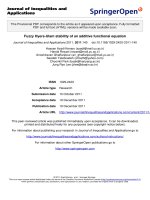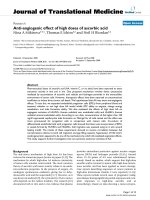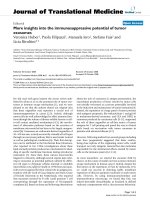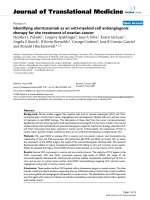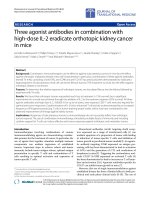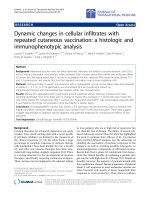Báo cáo hóa học: " Porous-ZnO-Nanobelt Film as Recyclable Photocatalysts with Enhanced Photocatalytic Activity" pptx
Bạn đang xem bản rút gọn của tài liệu. Xem và tải ngay bản đầy đủ của tài liệu tại đây (273.09 KB, 4 trang )
NANO EXPRESS
Porous-ZnO-Nanobelt Film as Recyclable Photocatalysts
with Enhanced Photocatalytic Activity
Min Wang
•
Guang Tao Fei
•
Li De Zhang
Received: 30 April 2010 / Accepted: 20 July 2010 / Published online: 6 August 2010
Ó The Author(s) 2010. This article is published with open access at Springerlink.com
Abstract In this article, the porous-ZnO-nanobelt film
was synthesized by oxidizing the ZnSe-nanobelt film in air.
The experiment results show that the porous-ZnO-nanobelt
film possesses enhanced photocatalytic activity compared
with the ZnO-nanobelt film, and can be used as recyclable
photocatalysts. The enhanced photocatalytic activity of the
porous-ZnO-nanobelt film is attributed to the increased
surface area. Therefore, turning the 1D-nanostructure film
into porous one may be a feasible approach to meet the
demand of photocatalyst application.
Keywords Porous materials Á ZnO Á Nanobelt Á
Photocatalyst
Introduction
In the past decade, some oxide semiconductors have been
widely used as photocatalysts for the degradation of
organic pollutants in water [1, 2]. Based on the viewpoint
of application, high photocatalytic activity and recyclabil-
ity are two major factors which should be regarded. Con-
sidering that photocatalytic reaction occurs at the surface of
catalysts, great efforts have been focused on nanoparticles
because high photocatalytic activity can be achieved owing
to their large surface area in a relative small volume (high
surface–volume ratio) [3–5]. Unfortunately, however, these
nanoparticle photocatalysts are generally suspended in
solution, which limits the practical application due to the
difficulty in their recycle [6]. In order to avoid this prob-
lem, some works have suggested that 1D-nanostructure
film adhered to a rigid substrate as photocatalysts [6–9].
However, 1D-nanostructure photocatalysts have relatively
low photocatlytic activity because of their lower surface-
to-volume ratio compared to nanoparticles. In a word, it
seems to be impossible to realize both high photocatalytic
activity and recyclability for semiconductor photocatalysts.
The porous 1D nanostructures, namely, nanoparticle
chains, in which nanoparticles connect each other and
constitute 1D nanostructure, have the speciality of both
nanoparticles and 1D nanostructures. Here, we propose that
turning 1D-nanostructure film into porous one is a feasible
approach to realize both high photocatlytic activity and
recyclability and thus to meet the demand of photocatalyst
application. Our results reveal that the as-synthesized
porous-ZnO-nanobelt film (PZNF) by oxidizing the ZnSe-
nanobelt film can be used as recyclable photocatalysts with
enhanced photocatalytic activity compared to the ZnO-
nanobelt film (ZNF).
Experimental Details
ZnSe nanobelts were prepared on Si substrate using
H
2
-assisted thermal evaporation method. They were syn-
thesized at 950°C for 30 min with the carrier gas of high-
purity Ar mixed with 5% H
2
. PZNF was obtained by
oxidizing the ZnSe-nanobelt film on Si substrate in air at
1,000°C for 2 min. In order to make a comparison of
photocatalytic activity, ZNF was prepared using the Au
film as catalyst by vapor phase transport method, the
growth process is similar to [5] The substrates before and
M. Wang Á G. T. Fei (&) Á L. De Zhang
Key Laboratory of Materials Physics and Anhui Key Laboratory
of Nanomaterials and Nanostructures, Institute of Solid State
Physics, Hefei Institutes of Physical Science, Chinese Academy
of Sciences, P.O. Box 1129, 230031 Hefei,
People’s Republic of China
e-mail:
123
Nanoscale Res Lett (2010) 5:1800–1803
DOI 10.1007/s11671-010-9715-x
after deposition were weighed to obtain the weight of the
as-prepared samples.
In order to examine the photocatalytic activity of sam-
ples, the methyl orange was chosen for photodecomposi-
tion study. Five milliliter methyl orange solution with a
concentration of 1.0 9 10
-5
M/L was added into two
quartz cells. The PZNF and ZNF with identical mass
(1.6 mg) on Si substrates were immersed into the solution.
They were irradiated by light with a wavelength of 365 nm
produced from a 125 W mercury lamp. The UV–vis
absorption spectra of the solutions, before and after irra-
diation interval of 40 min, were recorded using a Cary 5E
UV–Vis–NIR spectrophotometer.
Samples collected from the silicon substrates were
characterized by a field-emission scanning electron
microscopy (FE-SEM, Sirion 200), high-resolution trans-
mission electron microscopy (HRTEM, JEOL-2010), and
X-ray diffraction (XRD, Philips X’pert PRO).
Results and Discussion
The X-ray diffraction (XRD) pattern of the as-synthesized
ZnSe nanobelts is shown in Fig. 1a. It can be seen that
ZnSe nanobelts are of zinc blende structure (JCPDS 80-
0021). After annealing in air at 1,000°C for 2 min, they are
oxidized, and ZnO can be obtained corresponding to the
reaction equation ZnSe ? O
2
? ZnO ? SeO
2
, where
SeO
2
vaporizes [10]. The XRD pattern of the annealed
sample in Fig. 1b is consistent with wurtzite structured
ZnO (JCPDS 80-0075). There exists no peak of other
purity, except that from Si substrate. It indicates that ZnSe
is oxidized into ZnO.
The scanning electron microscopy (SEM) image in
Fig. 2a shows that micron-scale interspace exists among
the ZnO nanobelts by oxidizing ZnSe nanobelts. It would
make the organic pollutants easily enter and adsorbed by
the inner nanobelts, and thus the high photocatalysis effi-
ciency may be expected. Furthermore, each porous-ZnO
nanobelt is made up of a large number of pores and
nanoparticles, which connect each other and constitute a
nanoparticle chain. The transmission electron microscopy
(TEM) image in Fig. 2b reveals that each ZnO nanoparticle
has the diameter of about 50 nm. The high-resolution TEM
image (inset in Fig. 2b) indicates that each ZnO nanopar-
ticle is single crystal. This phenomenon originate from that
the outward diffusion flux of ZnSe is more than inward one
of O
2
and the net flow of ZnSe is balanced by inward flow
of vacancies, namely, the Kirkendall effect [11–13]. Due to
the quick oxidation reaction, the flaking and spallation
occur in pre-formed ZnO surface layer (Fig. 2b) [14]. As a
result, O
2
enters through the cracks and oxidizes inner
Fig. 1 XRD patterns of a and b correspond the as-synthesized ZnSe
nanobelts and porous-ZnO nanobelts, respectively
Fig. 2 a SEM image of the porous ZnO nanobelts on Si substrate.
The scale bar is 500 nm. b TEM image of a single porous ZnO
nanobelt. The inset is HRTEM of several ZnO nanoparticles. The
scale bar is 50 nm. c TEM image of a single solid ZnO nanobelt. The
inset is SAED. The scale bar is 500 nm
Nanoscale Res Lett (2010) 5:1800–1803 1801
123
ZnSe, and porous-ZnO nanobelts are obtained. In order to
make a comparison of photocatalytic activity, ZnO nano-
belts were also synthesized on Si substrate by vapor phase
transport method. Figure 2c is the TEM image of a single
solid ZnO nanobelt. Obviously, the porous ZnO nanobelt
has much higher surface-to-volume ratio than solid one, so
PZNF possesses higher surface area than ZNF with the
identical mass.
The photocatalytic activity of PZMF and ZMF with the
same mass (1.6 mg) of ZnO on Si substrates was investi-
gated using methyl orange molecules. The samples were
immersed in the solutions and irradiated with light from a
mercury lamp. The time-dependent UV–vis spectra of
methyl orange solution containing PZNF and ZNF, before
and after irradiation interval of 40 min, are illustrated in
Fig. 3a, b, respectively. It can be seen that the intensity of
absorption peak corresponding to the methyl orange mol-
ecules at 464 nm decreases with increasing the exposure
time. The variation of relative concentration of remaining
molecules with respect to irradiation time is given in
Fig. 3c. Nearly complete degradation of methyl orange
costs 160 and 400 min for PZNF and ZNF, respectively.
Obviously, PZNF has much higher photocatalysis effi-
ciency for the degradation of methyl orange than ZNF.
Because photocatalytic reaction occurs at the surface of
catalysts, we attribute this result to the higher surface area
in PZNF than that in ZNF with equal mass, which is further
confirmed below. The recyclability of PZNF is also stud-
ied. After recording the absorbance spectra of the solution
with irradiation for 80 and 160 min, PZNF was immersed
into fresh solutions of the same concentrations again for
another cycle of the photocatalysis experiment, and this
experiment was repeated for 10 times. The results are
shown in Fig. 3d. After 10 cycles, a little decrease in the
degradation rate was observed. This decrease may be due
to the unavoidable loss of the porous ZnO nanobelts into
solution during the experiment and the photocorrosion of
ZnO, because photocorrosion is a major obstacle for
photocatalysts such as ZnO and CdS [15, 16]. This result
reveals another very important point that the PZNF
obtained in this work can be effectively used as recyclable
photocatalysts. That is, PZNF obtained in our work pos-
sesses both high photocatalytic activity and recyclability.
After annealing PZNF in air at 1,000°C for 1 h, the
porous ZnO nanobelts (Fig. 2a, b) turn into solid one
because of the agglomeration of small ZnO grains, as
shown in Fig. 4a. It can be seen that grain boundary instead
of pore exists in the solid ZnO nanobelt. Thus, the surface
area decreases rapidly after annealing PZNF for 1 h. The
photocatalysis performance of PZMF before and after
annealing for 1 h, with an irradiation of 2 h, was revealed
in Fig. 4b. UV–vis spectra of 1 and 2 in Fig. 4b correspond
Fig. 3 The time-dependent
UV–vis spectra in a and b are
recorded for the methyl orange
solution containing PZNF and
ZNF, respectively. c The
variation of relative
concentration of remaining
methyl orange molecules with
respect to irradiation time.
d Degradation changes as a
function of irradiation time (80
and 160 min) over 10 cycles.
The beginning concentration C
0
is taken as that in a
1802 Nanoscale Res Lett (2010) 5:1800–1803
123
PZNF before and after annealing for 1 h, respectively. The
contrast experiment result shows that the photocatalysists
efficiency of PZNF decreases severely due to the
agglomeration of ZnO grains after annealing for 1 h, and
confirms definitely that the enhanced photocatalytic activ-
ity of PZNF is attributed to the increased surface area.
Conclusions
In summary, we propose that oxidizing 1D-nanostructure
film into porous one is a feasible approach to realize both
high photocatalytic activity and recyclability. Our results
reveal that the as-synthesized porous-ZnO-nanobelt film by
oxidizing the ZnSe-nanobelt film can be used as recyclable
photocatalysts with enhanced photocatalytic activity com-
pared to the ZnO-nanobelt film. Furthermore, the method
may be applied to obtain other porous materials.
Acknowledgments This work was supported by the National Nat-
ural Science Foundation of China (Nos. 50671099, 50172048,
10374090 and 10274085), Ministry of Science and Technology of
China (No.2005CB623603), and Hundred Talent Program of Chinese
Academy of Sciences.
Open Access This article is distributed under the terms of the
Creative Commons Attribution Noncommercial License which per-
mits any noncommercial use, distribution, and reproduction in any
medium, provided the original author(s) and source are credited.
References
1. J.M. Nedeljkovic, M.T. Nenadovic, O.I. Micic, A.J. Nozic,
J. Phys. Chem. 90, 12 (1986)
2. L.N. Lewis, Chem. Rev. 93, 2693 (1993)
3. A.L. Linsebigler, G. Lu, J.T. Yates, Chem. Rev. 95, 735 (1995)
4. I. Salem, Catal. Rev. Sci. Eng. 45, 205 (2003)
5. J.S. Hu, L.L. Ren, Y.G. Guo, H.P. Liang, A.M. Cao, L.J. Wan,
C.L. Bai, Angew. Chem. Int. Ed. 44, 1269 (2005)
6. H.S. Jung, Y.J. Hong, Y.R. Li, J.H. Cho, Y.J. Kim, G.C. Yi, ACS
Nano 2, 637 (2008)
7. J.L. Yang, S.J. An, W.I. Park, G.C. Yi, W. Choi, Adv. Mater. 16,
1661 (2004)
8. T.J. Kuo, C.N. Lin, C.L. Kuo, M.H. Huang, Chem. Mater. 19,
5143 (2007)
9. T.J. Sun, J.S. Qiu, C.H. Liang, J. Phys. Chem. C 112, 715 (2008)
10. C.X. Shan, Z. Liu, Z.Z. Zhang, D.Z. Shen, S.K. Hark, J. Phys.
Chem. B 110, 11176 (2006)
11. Y. Yin, R.M. Rioux, C.K. Erdonmez, S. Hughes, G.A. Somorjai,
A.P. Alivisatos, Science 304, 711 (2004)
12. H.J. Fan, M. Knez, R. Scholz, K. Nielsch, E. Pippel, D. Hesse, M.
Zacharias, U. Gosele, Nat. Mater. 5, 627 (2006)
13. H.J. Fan, M. Knez, R. Scholz, D. Hesse, K. Nielsch, M. Zacha-
rias, U. Gosele, Nano Lett. 7, 993 (2007)
14. C.Z. Yu, S.L. Zhu, D.Z. Wei, F.H. Wang, Surf. Coat. Technol.
201, 5967 (2007)
15. V. van Dijken, A.H. Janssen, M.H.P. Smitsmans, D. Vanmae-
kelbergh, K. Meijerink, Chem. Mater. 10, 3513 (1998)
16. B. Neppolian, H.C. Choi, S. Sakthivel, B. Arabindoo, V.
Murugesan, J. Haz. Mater. 89, 303 (2002)
Fig. 4 a TEM image of a single ZnO nanobelt obtained by annealing
the porous ZnO nanobelt in air at 1,000°C for 1 h. The scale bar is
100 nm. b UV–vis spectra of 1 and 2 correspond the methyl orange
solution, after 2 h irradiation, containing PZNF before and after
annealing for 1 h, respectively
Nanoscale Res Lett (2010) 5:1800–1803 1803
123
